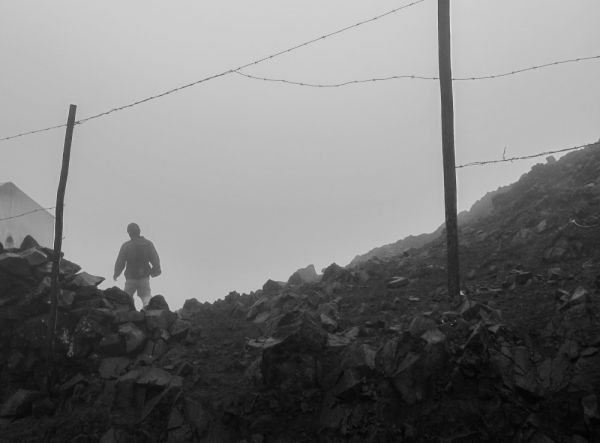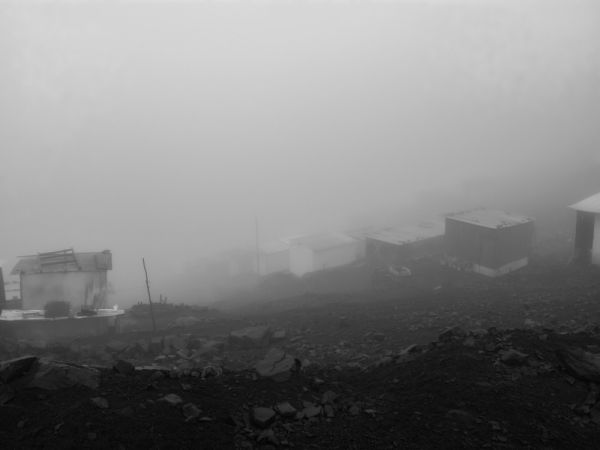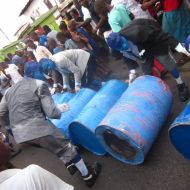Hill-Climbing Commuters Decry a Proposed Border Fence in Their Path

Commuters have trod a path over the hill separating two districts in Lima, one rich, one poor.
“We’re almost there,” says Rafael. We’ve been hiking for 25 minutes, and can just barely make out the top of the hill through the dense fog. I feel tired and winded. Dirt and rocks cover the surface of the hill, which separates the district of Villa Maria del Triunfo from La Molina. It’s 7:45 a.m. on a weekday and a handful of people are skillfully making their way down the slope into La Molina.
This overland route has been a standard way of moving between the two districts for some time – you can see the slender path that’s been carved into ground by thousands of footsteps. But earlier this year La Molina’s mayor announced a controversial plan to build a wall to separate them. Rafael traversed this route last April, when he wrote an article about the proposed wall for a local magazine.
At the top of the hill a fence made of thin barbed wire divides the districts, and extends as far as the eye can see. District security officials are stationed inside a green tent on La Molina’s side of the fence. A section of the wire has been cut, creating a gap that allows residents to pass to the other side. On a clear day you’d be able to see the hundreds of improvised homes that line the slope ahead of us, painted in bright yellows and blues. Once we pass through the fence, however, the fog makes it impossible to see more than 20 feet ahead.

The proposed border fence will force commuters to go around, adding significant travel time to their journeys.
The origins of Villa Maria del Triunfo can be traced back to the massive waves of migration that occurred in the second half of the twentieth century, and which led to scores of informal settlements. Today Villa Maria del Triunfo covers an area of about 70 square kilometers, and is home to over 355,000 people. Still, the area is marked by extreme poverty and precarious living conditions. Homes are made out of thin sheets of wood or metal, and several have stones on the top to hold down their roofs. According to a 2010 report in Villa Maria at least 23 percent of children under eight years of age suffer from chronic malnutrition.
The rapid expansion of Villa Maria has not been welcomed by La Molina, an upscale neighborhood that is home to over 125,000 people. Hence, La Molina Mayor Juan Carlos Zurek’s decision to build a wall as part of an effort to stop informal settlements, and to secure land for an ecological park that would be built in the area.
The announcement was criticized in the local media, and was seen as a veiled form of discrimination, even though the practice of building a wall to separate upscale neighborhoods from impoverished ones isn’t exactly a novel idea in Peru. In Las Casuarinas, a neighborhood in Lima, a concrete floodlit wall has cordoned off the area from the neighboring slum of Pamplona Alta for years.
“In Peru, especially Lima, very different ends of reality coexist and, from time to time, they collide,” Nicolas Kisic, an architect and urbanist, wrote in a column shortly after the announcement was made. “Walls can solve part of the problem, especially for those who are on one side of them, but there is no doubt they create a bigger problem, especially for those on the other side.”
A physical divide between La Molina and Villa Maria del Triunfo, Kisic wrote, would only accentuate the “separation and rupture that exists in the population today.”

The houses of Villa Maria del Triunfo.
On the hill I talk to David, who works as a security guard in La Molina, and traverses the hill back to his home in Villa Maria del Triunfo every day. “I work from seven at night to seven in the morning,” he says. Despite his graveyard shift and the long slog up the slope, he shows no signs of exhaustion. He says he’s heard of the proposed wall, but points out that nothing has changed so far. “Everything is calm.”
David says that if he weren’t allowed to walk over into Villa Maria del Triunfo, he’d have to take three buses to get back home, a journey of close to two hours. “Then it would be another 30 minutes walking from the bus stop,” he says. “We hope everything remains as it is.” Then he says goodbye, ducks beneath the barbed wire and disappears into the fog.
Photos by Manuel Vigo









